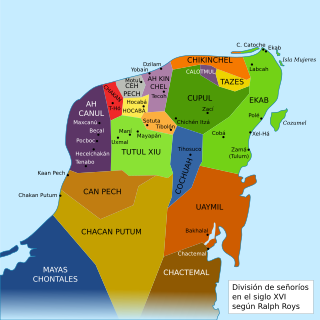This article may be expanded with text translated from the corresponding article in Spanish. (July 2012)Click [show] for important translation instructions.
|

Chikinchel (also called Chauacá)(in Yucatec Mayan: Chikinchel de Chinkín) was the name of a Mayan chiefdom of the northern coast of Yucatán, before the arrival of the Spanish conquistadors in the sixteenth century. [1] Chauaca has also been used to name this province, but apparently it was the name of the main city.

The Maya civilization was a Mesoamerican civilization developed by the Maya peoples, and noted for its logosyllabic script—the most sophisticated and highly developed writing system in pre-Columbian Americas—as well as for its art, architecture, mathematics, calendar, and astronomical system. The Maya civilization developed in an area that encompasses southeastern Mexico, all of Guatemala and Belize, and the western portions of Honduras and El Salvador. This region consists of the northern lowlands encompassing the Yucatán Peninsula, and the highlands of the Sierra Madre, running from the Mexican state of Chiapas, across southern Guatemala and onwards into El Salvador, and the southern lowlands of the Pacific littoral plain.
A chiefdom is a form of hierarchical political organization in non-industrial societies usually based on kinship, and in which formal leadership is monopolized by the legitimate senior members of select families or 'houses'. These elites form a political-ideological aristocracy relative to the general group.
After the destruction of Mayapan (1441–1461), in the Yucatán Peninsula, it created rivalries among the Maya, and formed 16 separate jurisdictions, called Kuchkabals. In each Kuchkabal there was a Halach Uinik (in Mayan: Halach Uinik), who was the chief with the most political, judicial, and militaristic authority and lived in a principal city considered the capital of the jurisdiction.

Mayapan, , is a Pre-Columbian Maya site a couple of kilometers south of the town of Telchaquillo in Municipality of Tecoh, approximately 40 km south-east of Mérida and 100 km west of Chichen Itza; in the state of Yucatán, Mexico. Mayapan was the political and cultural capital of the Maya in the Yucatán Peninsula during the Late Post-Classic period from the 1220s until the 1440s. Estimates of the total city population are 15,000–17,000 persons, and the site has more than 4,000 structures within the city walls, and additional dwellings outside.

The Kuchkabal, Ah Kuch-Kab, or Ah Cuch-Cab were the forms of government used by the pre-Columbian nations of the Yucatan Peninsula. There were somewhere between 16 and 24 kuchkabalob in the 16th century. Kuchkabal could also refer to the ruling family.
Halach uinik or halach uinic was the name given to the supreme ruler, overlord or chief, as they were called in the colonial period of a Maya kuchkabal.





